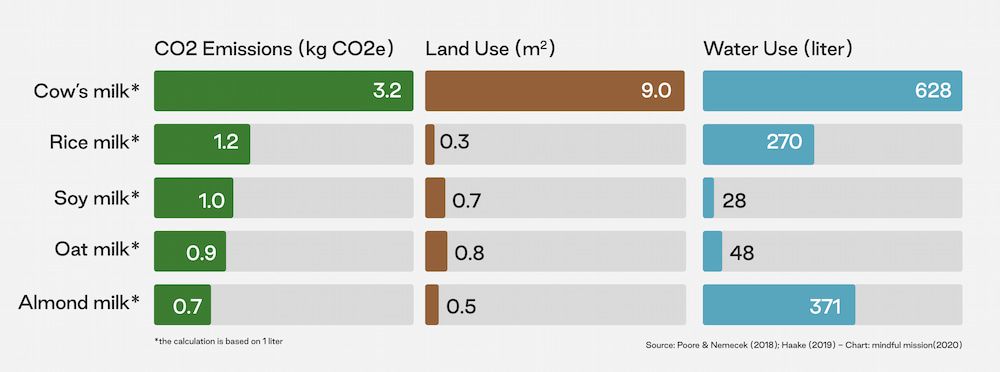It seems as if every week a new plant declares war on dairy products. Plant-based milk options take over your local supermarket shelves while grandma still tries to convince you to stick to conventional milk. When it comes to milk and its alternatives, it's easy to lose track, especially when it comes to the impact on climate.
We have collected the most important facts about milk and all things climate to help you get back on track! First and foremost, the CO2 emission balance of the different milks at a glance.
Cow's milk
Some studies report that the production of one liter of cow's milk is about as damaging as burning one liter of gasoline. Due to the cows' digestion, which releases the greenhouse gas methane, the production process of milk heavily impacts the environment. In the case of cow’s milk, however, a distinction must be made. The different circumstances under which the milk is produced are crucial for deciding whether the product is climate-friendly or not. Only factory farmed milk can be compared to the environmental impact of gasoline. A cow that is allowed to graze in the meadow and whose dung is used for fertilization is not only happier, but also far less harmful to the climate.
Can milk alternatives challenge cow’s milk in terms of climate friendliness?
American market research institutes predict that plant-based dairy products will continue to grow strongly until 2025 and reach a market value of 36.7 billion US dollars worldwide. This is not only a result of the great demand due to veganism and lactose intolerance, but also due to increased environmental awareness among consumers. But which milk alternative turns out to be the climate winner?
Soy milk
The drink made of soybeans is the most popular milk alternative in America and Europe. But like cow's milk, the soy alternative also shows both advantages and disadvantages. The industrial cultivation of soybeans turns out to be quite problematic, because a large part of harvested soy is cultivated in the Amazon rainforest, where large fields are deforested. However, it should be noted that 97% of the scrap is used as feed for farm animals. Solely looking at the milk produced using soybeans, the results of a study by the University of Oxford shows that the production of soy milk uses significantly fewer resources than cow's milk. The CO2 emissions of this plant-based alternative add up to just under ⅓ of the emissions of cow’s milk.
Almond milk
While this plant-based milk alternative can shine in terms of popularity, the climate friendliness unfortunately leaves a lot to be desired. Most of the imported almonds come from California. Huge monocultures not only damage flora and fauna, but also swallow vast amounts of water. Researchers at the University of California compared the production of one liter of almond and cow milk. While the production of the plant-based alternative has relatively low emissions with 0.7 kg of CO2 per liter, almonds require immense amounts of water. Taking into consideration California’s drought, the ecological balance of almond milk is rather negative.
Rice milk
The plant-based milk alternative made from rice may have a sweet taste, but it’s aftertaste is quite bitter: Unfortunately, rice milk turns out to be a not particularly sustainable alternative to conventional cow milk. Not only long transport routes and CO2-intensive production methods harm the environment, but growing rice not only uses up a lot of water, but also releases methane, which negatively impacts climate change.
Oat milk
The milk alternative made of oats clearly stands out due to its regionality. Most manufacturers can source the grain locally. Shorter transport routes and relatively neutral CO2 cultivation enable climate-friendly production of the drink. Oat drinks also require significantly less water and land usage than cow's milk. Compared to almond milk, the production of oat milk emits slightly more kgs of CO2, but considering all options, oat milk has a good ecological balance.
Who will win the title of “most climate-friendly milk alternative”?
At TeamClimate, we calculate, reduce and offset CO2 emissions. We pursue the goal of climate neutrality and fight climate change every day. Therefore, it’s obvious that the winner of milk options has to score high in terms of environmental friendliness: low CO2 emissions, minimal water consumption and small use of land.

Our conclusion: oat milk is simply amazing and therefore TeamClimate approved!
You’d like to be simply amazing as well? Calculate your CO2 emissions and become a climate neutral human with us!
Sources: marketsandmarkets (2020): Dairy alternatives market GEO (2019): Sind Milchalternativen besser für die Umwelt? science ORF.at (2019): So nachhaltig sind Milchalternativen Poore, J., & Nemecek, T. (2018): Reducing food’s environmental impacts through producers and consumers Albert Schweitzer Stiftung (2018): Zur Ökobilanz von Pflanzenmilch Tabitha, W. (2019): What Milk Should You Buy To Reduce Your Environmental Impact? Oaty (2017): sustainability report Haake, D. (2019): Which milk has the smallest impact on the planet?


